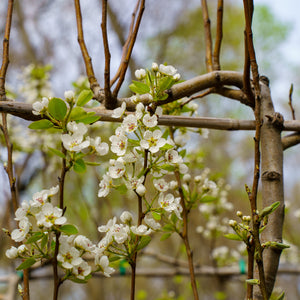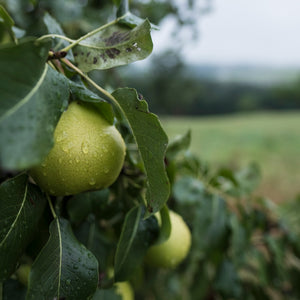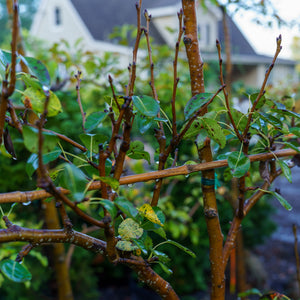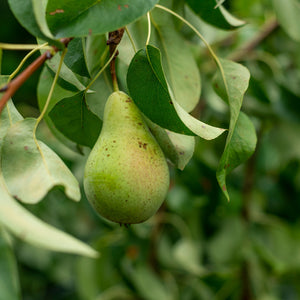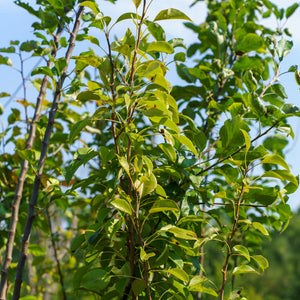The Pear Tree Guide
Pear trees grace your landscape with a timeless and majestic presence. With their dignified stature, lovely bark, and graceful leaves, pear trees captivate attention and infuse an air of grandeur into your outdoor spaces. These splendid trees are celebrated for their adaptability, thriving in diverse conditions with appropriate care and maintenance. Whether you aspire to cultivate a serene orchard or introduce a distinguished highlight to your garden, pear trees stand as an exceptional choice.
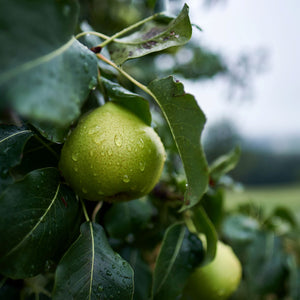
About
Pear trees, members of the Pyrus genus, encompass a variety of deciduous trees celebrated for their captivating presence and ecological significance. These trees, with numerous recognized species, thrive across temperate regions in the Northern Hemisphere, spanning North America, Europe, and Asia. Pear trees are distinctive, boasting features that significantly contribute to local ecosystems.
One of the standout characteristics of pear trees is their enticing bark, often smooth and displaying an eye-catching contrast against their foliage. The leaves of pear trees typically take an oval shape, adorned with serrated edges and vibrant green hues during the growing seasons. As autumn graces us with its presence, pear trees undergo a breathtaking transformation, offering a splendid array of warm colors, from yellows to oranges, and even shades of copper.
Pear trees are renowned for their ecological importance, serving as both a source of sustenance and shelter for various wildlife. In spring, they produce delicate flowers, arranged in small clusters known as inflorescences, which offer early-season pollen for essential pollinators like bees and other beneficial insects. The seeds of pear trees, nestled within prickly husks, are a valuable food source for a diverse array of birds and mammals.
These versatile trees display adaptability to various soil types and environmental conditions. While they prefer well-drained, moist soil, pear trees can flourish in both full sun and partial shade. Their resilience in different climatic conditions, combined with a moderate growth rate, renders them a favored choice for landscape design and ecological contributions.
Whether used as a captivating focal point in a garden, strategically grouped to create windbreaks, or thoughtfully integrated into mixed borders, pear trees bring an air of elegance and beauty to any landscape. Notable species include the European pear (Pyrus communis) and the Asian pear (Pyrus pyrifolia), celebrated for their striking appearances and the ecological significance they carry.
By selecting and nurturing pear trees in your landscape, you enhance the visual charm of your outdoor spaces and contribute to the preservation of these remarkable trees and the biodiversity they support.

Planting
Pear trees have specific planting and care requirements to ensure their successful growth and fruit production. Here are some general guidelines for planting and tending to pear trees:
Soil: Pear trees thrive in well-draining soil that is rich in organic matter. They prefer slightly acidic soil with a pH between 6.0 and 7.0. To prepare the planting site, loosen the soil and incorporate compost or organic matter. This not only improves drainage and fertility but also provides the tree with essential nutrients for healthy growth.
Sunlight: Pear trees prefer full sun to partial shade. When selecting a location, ensure it receives at least six hours of direct sunlight each day. However, they can tolerate partial shade, which can be especially beneficial in regions with hot and dry climates.
Watering: Adequate and consistent watering is crucial, particularly during the tree's initial establishment. After planting, water the tree deeply to settle the soil and promote root establishment. In the first year, maintain a regular watering schedule, typically requiring deep and thorough watering once or twice a week. Adjust the frequency based on rainfall and soil moisture levels. Avoid overwatering, as excessively wet soil can lead to root rot.
Mulching: Apply a layer of organic mulch around the base of your pear tree. Mulch helps conserve moisture, suppress weed growth, and regulate soil temperature. Materials like wood chips, bark, or compost work well. Ensure the mulch is a few inches away from the tree's trunk to prevent moisture accumulation, which can lead to bark and root issues.
Pruning: Pear trees generally require pruning to maintain their shape, encourage airflow, and remove dead, damaged, or crossing branches. Pruning is best done during late winter or early spring while the tree is dormant, before new growth begins. Always use clean, sharp pruning tools to minimize the risk of damaging the tree.
By following these basic planting and care guidelines, you can ensure the successful establishment and healthy growth of your pear trees. With the right care, your pear trees will flourish, providing you with delicious fruit and enhancing the beauty of your landscape for years to come.
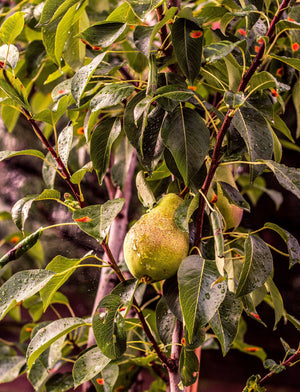
Care
Pear trees, part of the Pyrus genus, have specific care requirements to ensure their optimal growth and the production of healthy, delicious fruit. Here are some general guidelines for the care of pear trees:
Watering: During the growing season, it's essential to provide consistent and moderate watering for your pear trees. Aim for about one inch of water per week, adjusting as necessary based on rainfall and local weather conditions. Deep and thorough watering is crucial to encourage deep root growth. Shallow watering should be avoided, as it can lead to stress and dehydration for the tree. In periods of drought or high temperatures, be prepared to provide additional watering to keep the soil adequately moist.
Pruning: Pear trees typically require some pruning to maintain their shape, ensure good airflow, and remove dead, damaged, or crossing branches. While they may not need extensive pruning, it's advisable to shape the tree to achieve the desired size and form. Pruning is best done during late winter or early spring before new growth begins. It's important to use clean, sharp pruning tools to minimize the risk of damaging the tree. Additionally, deadheading spent flowers can encourage new growth and potentially trigger a second flowering.
Fertilizing: Fertilization can promote healthy growth and a bountiful fruit harvest in pear trees. Apply a balanced, slow-release fertilizer in the spring or early summer, following the recommended application rates and timing provided by the manufacturer. It's crucial to avoid over-fertilization, as excessive fertilizer can harm the tree's roots. When in doubt, it's better to be cautious and use less fertilizer.
Soil and Sunlight: Pear trees thrive in well-drained, moist soil and prefer full sun exposure. While they are relatively tolerant of different soil types, providing well-draining soil is essential for their optimal growth. Mulching around the base of the tree can help retain moisture and regulate soil temperature, creating a more favorable environment for the tree.
Pests and Diseases: Although pear trees are generally resistant to pests and diseases, it's important to monitor them for common issues such as pear psylla, fire blight, and codling moths. If you observe any signs of damage or disease, it's crucial to take prompt action and treat the tree with appropriate measures such as insecticides or fungicides.
By following these basic care guidelines, your pear trees will thrive, providing you with an abundance of delicious fruit and enhancing the beauty of your garden for years to come.
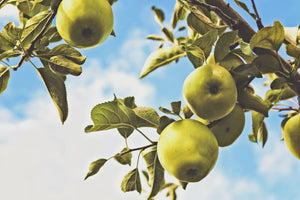
How To Use
Pear trees, belonging to the Pyrus genus, offer a wide array of benefits and can be integrated into your landscape in numerous ways. Here are some recommendations based on their characteristics:
Focal Point: Pear trees exhibit an elegant and captivating presence, making them a perfect choice as a focal point in your landscape. Planting a single pear tree in an open area allows you to showcase its graceful form and the beauty of its blossoms and fruits. Alternatively, you can create a stunning visual impact by planting a cluster of pear trees together, forming a striking centerpiece for your garden.
Shade Tree: With their broad, leafy canopies, pear trees provide excellent shade. Strategically plant them near outdoor seating areas, patios, or decks to create cool and comfortable spaces for relaxation and outdoor enjoyment during hot weather. The dappled shade they cast is both refreshing and inviting.
Windbreak: Pear trees can serve as a natural windbreak due to their dense foliage and sturdy growth. Plant them in a row to shield your garden, home, or other outdoor spaces from strong winds, providing an effective barrier that enhances your comfort and protects against the elements.
Privacy Screen: Utilize the dense foliage of pear trees to create a natural privacy screen within your landscape. Plant them in a row along your property line to establish an attractive, functional barrier that enhances both your privacy and the visual aesthetics of your surroundings. These trees not only provide seclusion but also add beauty to your outdoor space.
Wildlife Habitat: Pear trees contribute to the biodiversity of your garden by attracting various wildlife species. Birds and other animals are drawn to the fruits and shelter provided by pear trees. By planting pear trees, you can create a welcoming habitat for wildlife, allowing you to enjoy the sights and sounds of nature flourishing in your outdoor environment.
When selecting pear trees for your landscape, consider their growth rate and environmental requirements. Ensure they are planted in areas that receive adequate sunlight and provide well-drained soil. With their graceful form, beautiful blossoms, and delectable fruits, pear trees are an exceptional addition that enhances both the beauty and functionality of your outdoor space.
Conclusion
Pear trees are a captivating and versatile addition to any landscape. Their remarkable presence, unique foliage, and ecological significance make them a sought-after choice for various settings. By adhering to proper planting and care practices, you can enjoy the beauty and benefits of pear trees in multiple ways, whether it's creating a picturesque orchard or providing a source of fresh, homegrown fruit. Whether you choose to showcase their elegance as a focal point in your garden or incorporate them into a larger design, pear trees offer endless possibilities to enhance the allure of your outdoor space. With dedication and care, you can create a breathtaking landscape that will bring you lasting joy and delicious harvests for years to come.

